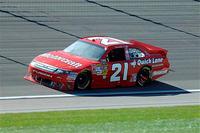Sprint Cup - Record Numbers, Competitive Balance Highlight NASCAR Sprint Cup Series First Half
 |
DAYTONA BEACH, July 13, 2011: Trevor Bayne opened the story of 2011, a surprise winner in the biggest race of them all – an event which featured a track-record number of leaders and lead changes.
Acting as the perfect table-setter, the 53rd Annual Daytona 500 set a tone for the entire first half, one that featured three first-time winners – Bayne, Regan Smith and David Ragan – and the highest leader and lead change numbers in the 63-year history of the series.
"I would say that parity is really the first thing that comes to mind [when thinking about the first half],” said five-time defending series champion Jimmie Johnson. “There have been some guys that have flexed muscle at times, but no one consistently has just schooled everybody. It's been very, very equal this year and unpredictable, if you will. A lot of first-time winners, which is great to have, and no runaways right now so it's been an exciting time for the fans I believe. And then also, we've been acting like fools out there at times so that's always spicing things up."
In some cases, the first half boasted numbers previously unseen in NASCAR Sprint Cup Series history. Here are some of the statistics gleaned from the first 18 races:
12 different winners. Last time there were more through 18 races was
2003. Last year, there were seven different first-half winners
12
different Coors Light Pole winners
An average of 14 different leaders
per race, most through 18 races in history
An average of 31 lead
changes per race, most through 18 races in history
44 different drivers
have led at least one lap
30 drivers have scored at least one top
10
Average Margin of Victory of 1.552 seconds
9 races with an MOV
under one second
Average of 3,940 passes per race, the most through 18
races since the inception of Loop
Data in 2005.
Average of 39 green flag passes for the lead (all around the track), second-highest total through 18 races since the inception of Loop Data in 2005.